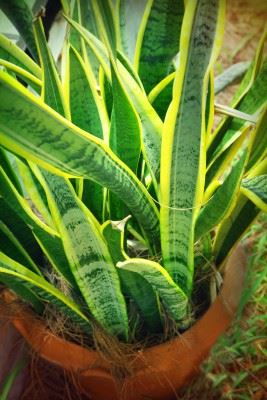






The sansevieria trifasciata picked up the name mother in laws tongue from the sharpness of the evergreen sword like leaves that grow in an upward fashion. As mentioned above this plant is a flowering type, however, grown indoors it's fairly hard to encourage flowers (not impossible).
Varieties: There is a number of these succulent type varieties available that includes, golden edged leaves, white edged and the green and grayish mottled type. The golden edged leaf S. trifasciata laurentii is the most common of these.
Flowering: Small greenish white flowers can appear once this species matures in age. This seems as though it happens by luck rather than effort for some growers. Keeping to the correct conditions gives the plant a higher chance of buds and then flowers appearing.
Foliage: The tall looking leathery upright leaves is what makes this succulent visually appealing rather than the flowers that may appear. The leaves are fleshy that sit within a rosette arrangement and can grow up to 3ft tall.
Air purifitying: While all plants purify air-borne toxins the snake plant is among the top plant's tested and added to a list by NASA (National Aeronautics and Space Administration) for removing, benzene, formaldehyde and other harmful toxins.
Poisonous for pets: If cats or dogs ingest parts of this plant it can cause them to feel unwell, start vomiting or have diarrhoea. They are not highly toxic but still can cause uncomfortable symptoms.

Base rot: The most common cause here is over watering in cold conditions which may first be identified by the leaves yellowing or drooping. You will need to remove the most affected parts or discard the whole plant if all the base is completely affected.
If you know you have not over watered check the temperature of the room because it may just be below 50°F (10°C)and causing the rot. Remember to take cuttings for propagation if this happens - unfortunately .
Copyright © www.100flowers.win Botanic Garden All Rights Reserved